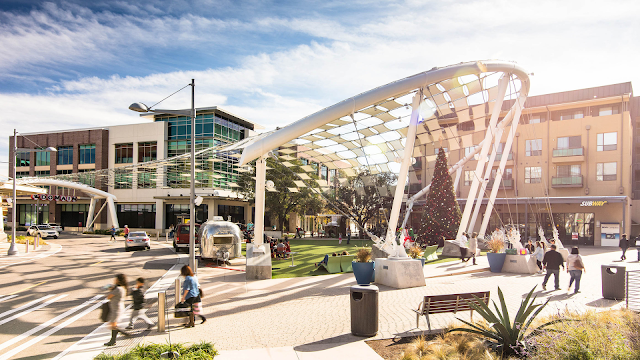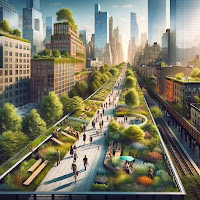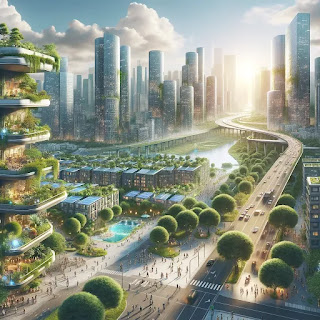 |
| image from stantec |
The Essence of Land Development
At its core, land development is about increasing land's value. This is done by making it suitable for specific uses. These uses can include building homes, businesses, or repurposing old buildings. It blends engineering, design, and urban planning. It also includes environmental science. The goal is to create spaces that are sustainable and appealing.
Land development starts with an idea. Then comes much research and planning to ensure the project can be done. The design phase brings together architects and engineers. They draft detailed plans, leading to getting needed permits and, finally, construction.
The Critical Role of Land Development in Urban Planning
Land development is vital for urban planning, offering a means to shape our living and working environments. It not only improves residents' quality of life but also fosters economic growth and job creation. Using land efficiently can reduce urban sprawl. It can also preserve natural resources. This helps create sustainable communities.
This process also lets cities evolve with changing demographics and needs. It ensures housing, commercial spaces, and infrastructure can keep up with growth.
The Process of Land Development
Land development is complex. It has several stages. Each stage needs careful planning and execution. While the specific steps may vary depending on the project and location, the general process can be divided into the following stages:
1. Feasibility and Site Analysis
This stage involves conducting a thorough analysis of the site to assess its suitability for development. We consider factors like topography, soil, the environment, and amenities. We conduct feasibility studies. They determine if the project is viable and its risks.
2. Design and Planning
Once the site analysis ends, architects and engineers collaborate. They create detailed plans and blueprints for the development. This includes designing the layout. It involves determining building heights and densities and considering infrastructure needs. For those seeking expert land development services, Land Development Services offers comprehensive support to ensure your project's success.
3. Obtaining Permits and Approvals
Before construction can begin, developers must obtain the necessary permits and approvals from local authorities. This may include zoning approvals, environmental permits, and building permits. Compliance with regulations and adherence to local codes and guidelines is crucial at this stage.
4. Construction and Development
With permits in hand, the construction phase begins. This involves site preparation, building construction, infrastructure installation, and landscaping. Managing and coordinating projects is essential. It ensures the smooth execution of development.
5. Post-Development
Once the construction is complete, the project enters the post-development phase. This includes inspections, quality control, and addressing any issues or deficiencies. It may also involve marketing and sales efforts for residential or commercial properties.
Land Development Regulations and Permits
Land development is subject to various regulations and permits to ensure that it aligns with local laws and guidelines. The rules aim to protect public health. They also aim to preserve the environment and promote sustainable development. Developers must understand and comply with these regulations. It is crucial to avoid delays, penalties, and legal issues.
Zoning regulations dictate how land can be used within a specific area. They determine whether the land can be used for residential, commercial, industrial, or mixed-use purposes. Developers must ensure that their proposed land use aligns with the zoning regulations of the area.
Environmental permits are required. This is to assess. It will also reduce the impact of development on the environment. These permits may involve studies on the site's ecological systems, water resources, and air quality. Developers must demonstrate measures to minimize environmental harm and preserve natural resources.
Building permits are essential. It ensures the constructed buildings meet safety and structural standards. You get these permits after you submit detailed plans. They are for review by architects and engineers. You must comply with building codes, fire safety rules, and accessibility requirements. This compliance is crucial to get these permits.
In addition to these permits, developers may also need to get approvals for utilities. They will also need them for transportation infrastructure and other public services. Following regulations and getting the needed permits is key. It's part of responsible land development.
Sustainable Land Development Practices
Sustainable land development focuses on creating eco-friendly and socially responsible spaces. They use fewer resources and cut carbon emissions. It aims to strike a balance between development and preservation. It ensures the needs of present and future generations. It does this without harming the environment.One key principle of sustainable land development is preserving natural resources. It also involves protecting biodiversity. This can be done by adding green spaces. It can also be done by saving wetlands and forests. And by taking steps to reduce soil erosion and water pollution.
Energy efficiency is another important aspect of sustainable development. This means using renewable energy. It means designing buildings that use little energy. And, it means promoting energy-saving practices. These include efficient lighting and HVAC systems.
Sustainable transportation is also a critical component of land development. This includes designing walkable neighborhoods. It also includes promoting cycling paths. And, it means combining public transit systems. This is to reduce reliance on private vehicles.
Lastly, sustainable land development emphasizes community engagement and social equity. It involves creating inclusive spaces. They cater to diverse communities. It promotes affordable housing and supports local businesses. Involving the community in development can create sustainable land. It fosters a sense of ownership and pride.
The Integral Role of Architects and Engineers
Architects and engineers are crucial in transforming land development ideas into reality. They collaborate to make sure projects are not aesthetically pleasing. They also make sure they are practical, sustainable, and compliant to all regulations.
Challenges and Opportunities in Land Development
Land development presents both challenges and opportunities for developers, planners, and communities. Understanding these challenges and using the opportunities is key. It is vital for successful and lasting development.
Balancing economic growth with saving the environment is a main challenge in land development. Rapid urbanization can destroy natural habitats. It also causes more pollution and resource depletion. Sustainable land development practices seek to address these challenges. They do this by giving priority to conservation, energy efficiency, and community well-being.
Another challenge is the complexity of regulations and permit processes. Navigating the legal requirements takes time and money. You also need to obtain necessary approvals. Developers must stay informed about local rules. They must work closely with relevant authorities to ensure compliance.
In addition to challenges, land development also presents opportunities for innovation and creativity. Developers can use new technologies and designs. They can use them to create smart, sustainable cities. Using renewable energy, smart infrastructure, and green building can make developments more efficient. It can also make them more resilient.
Also, land development can boost economic growth. It does this by creating jobs, attracting investments, and reviving communities. Developers can improve the region by fixing unused or blighted areas. This helps the region's well-being and prosperity.
Case Studies of Successful Land Development Projects
To show the impact and potential of land development, let's look at two success stories: the High Line in New York City and the King's Cross Redevelopment in London.
Case Study 1: The High Line, New York City
The High Line is an elevated linear park built on a historic freight rail line on Manhattan's West Side. The project changed a derelict structure into a lively public space. It attracts millions of visitors each year. The High Line repurposed an abandoned railway. It saved a piece of New York City's industrial history. It also made a unique urban oasis. The project has revitalized the surrounding neighborhoods,. This has led to increase property values, new businesses, and community engagement.
Case Study 2: King's Cross Redevelopment, London
The King's Cross Redevelopment project in London transformed an old industrial site. It made it into a thriving neighborhood with homes and businesses. The project involved the regeneration of 67 acres of land, creating new homes, offices, retail spaces, and public parks. The development focused on sustainability. It included energy-efficient buildings, green spaces, and a full transportation network. The project has revitalized the area. It has attracted businesses, residents, and visitors. It has done this while preserving the site's heritage.The case studies show the power of land development. It is transformative when done thoughtfully and sustainably. They serve as inspiring examples of how land can be repurposed and developed to benefit communities and enhance urban environments.
The Future of Land Development and Emerging Trends
The field of land development is constantly evolving. It is driven by technological advancements, changing demographics, and environmental concerns. Several emerging trends are shaping the future of land development:
1. Smart and Sustainable Cities
The concept of smart cities, characterized by the integration of technology and data-driven solutions, is gaining momentum. Land projects are adding smart infrastructure. They also add renewable energy systems and IoT (Internet of Things) devices. This is to create more efficient and sustainable urban environments.
2. Mixed-Use Developments
Mixed-use developments are becoming popular. They combine residential, commercial, and recreational in one area. These developments promote walking. They also reduce commutes and create lively communities. In these places, people can live, work, and play nearby.
3. Adaptive Reuse and Historic Preservation
More people care about sustainability. So, reusing and preserving historic buildings are gaining traction. Developers are repurposing old buildings and structures. They keep their importance for architecture and history. But, they also make them usable for modern needs.
4. Climate Change Resilience
The impacts of climate change are becoming more clear. Land development projects are adding measures to improve resilience. This includes designing buildings and infrastructure that can withstand extreme weather events, implementing green infrastructure to manage stormwater, and integrating renewable energy systems to reduce carbon emissions.
5. Community-Centric Development
Land development is increasingly focusing on community engagement and social equity. Developers are involving local communities in planning and design. They want to ensure that the development meets the communities' needs and aspirations. We prioritize affordable housing. We also prioritize public spaces and amenities. This creates inclusive and livable neighborhoods.




Comments
Post a Comment